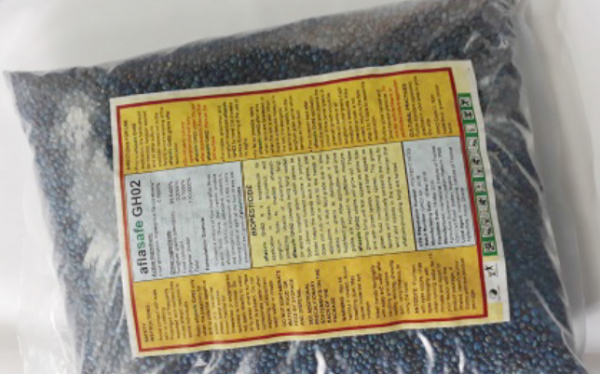
Combating deadly aflatoxin in Ghana’s food, the Aflasafe GH02 solution
Food, they say, is medicine. But can this be said for many Ghanaian foods that are consumed in large quantities every day? Key staple and cash crops such as maize and groundnuts are particularly vulnerable to aflatoxin contamination.
Advertisement
Danger
These poisons are not only dangerous for people, but also for animals, including livestock, even in low concentrations. People and animals get aflatoxin from food and animal feed, respectively, prepared from contaminated crop produce.
Africa and the tropical world are at a distinct disadvantage: although aflatoxin-producing fungi (or
Maize, groundnuts, sorghum,
Detecting aflatoxin
Regrettably, aflatoxins are not visible to the naked eye in food, making their easy detection difficult, nor can their poison be destroyed by cooking. Nevertheless, chronic consumption of aflatoxins by people and animals results in visible ill effects on health. These include low birth- weight in infants, stunting in children, reduced immunity, liver cancer, low productivity in animals, and, in high consumption, death. Evidence
Evidence in poultry
Actors in the poultry industry also attest to low egg production, reduced live weight and increased mortality when birds are fed with aflatoxin-contaminated feed. There have been reports
Kenkey and aflatoxins
Ghanaians will vividly recall the sensational media reports and heated debates on “Kenkey causes cancer” that dominated the airwaves and print media in August and September 1998. Certainly, these raised awareness on aflatoxins among the citizenry at the time and further stimulated efforts for empirical research on aflatoxin and its management.
Thereafter, several aflatoxin surveillance studies detected varying levels of the toxins in maize, groundnuts, and their derivative products. To cite but a few, aflatoxin levels reaching 4,800 parts per billion (ppb; a ppb is akin to one drop of water in an Olympic-size swimming pool) were detected in market samples of maize in Accra.
Toxin level in fermented maize dough was found to be up to 289 ppb, Kenkey 51 ppb, groundnut 216 ppb, groundnut paste > 3,200 ppb, and Tom Brown 104 ppb.
Indeed, these aflatoxin levels exceeded the safety limit for human consumption.
Threshold
The Ghana Standards Authority (GSA) sets the threshold at 15 ppb for maize and 20 ppb for groundnuts. Critically, those contamination levels clearly demonstrate that majority of Ghanaians are exposed to unsafe aflatoxin levels in foods (Banku, Kenkey,
Aflatoxins affect not only our health but also have adverse impacts on our trade and economy. Ghana receives persistent notifications from the Rapid Alert System for Food and Feed, a system that reports food safety issues within the European Union, on excessive aflatoxin levels in foods including groundnut, groundnut butter, maize meal and Kenkey. The fact
One way street
Aflatoxin contamination is a one-way street: once aflatoxins move in, they cannot be removed completely from the crop or its products. These toxins are heat-stable and cannot be destroyed by cooking (although the aflatoxin-producing
But most of these technologies are not always sufficient to ensure that foods are aflatoxin-safe, plus most are after the fact of aflatoxin having moved in.
Aflasafe
One pre-contamination strategy that has
Applied whilst the crops are still in the field, Aflasafe displaces the aflatoxin-producing
Aflasafe was developed by the International Institute of Tropical Agriculture (IITA), in collaboration with the United States Department of Agriculture – Agricultural Research Service (USDA–ARS) and the Kwame Nkrumah University of Science and Technology.
GH02
The product specially tailored for Ghana is Aflasafe GH02. Aflasafe GH02 is made from four non-aflatoxin producing (
With just 4 kilos of Aflasafe, a farmer can effectively protect an entire acre of maize, groundnuts or sorghum, and thereby meet the stringent international and domestic aflatoxin standards. The result is increased farmer
The availability of Aflasafe on the Ghanaian market opens more doors for agribusiness investment, particularly in product manufacture and distribution as well as downstream businesses trading in aflatoxin-safe commodities. Currently, the product is manufactured at IITA’s headquarters in Ibadan, Nigeria.
The current retail price includes transport from Ibadan and duties. Through the Aflasafe Technology Transfer and Commercialisation initiative (ATTC),
By their stealthy nature, aflatoxins in our diets are silent killers. The onus to control aflatoxin in food falls on all of us who produce and eat food, from the farmer to the consumer. Firstly, to be aware of the perils of aflatoxin contamination in our food. Secondly, to appreciate its toll on health and trade.
And finally, to be willing, determined and consistent in implementing aflatoxin safety measures along the entire crop value chain to ensure sale and consumption of aflatoxin-safe food. Unless there is



